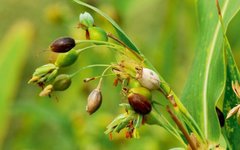Coix seed is one of the earliest staple foods used by the Chinese and is also the most effective diuretic in Traditional Chinese Medicine (TCM), representing a brilliant pearl in Huaxia culture.Archaeological analysis of relics from the Hemudu site has revealed that coix seeds have a history of over 6000 years. At least since the Xia Dynasty, coix seeds have been used as a major grain, prepared in forms such as porridge and wine.
Coix seed is also known as Yi Mi (Job’s Tears)
Coix seed is the mature seed of the plant Coix lacryma-jobi, which is an annual or perennial herb, growing to about 1.5m in height, found near houses, in wild areas, by rivers, streams, or in damp valleys. It is distributed in most regions of China, with Sichuan being its place of origin, hence it is also called “Chuan Gu”. Legend has it that Yu’s mother “swallowed the divine pearl coix seed, and gave birth to Yu”; the birthplace of Da Yu is in the Shiniu Mountain on the southern bank of the Jianjiang River in Beichuan County, Sichuan Province. Nowadays, Guizhou cultivates it extensively.
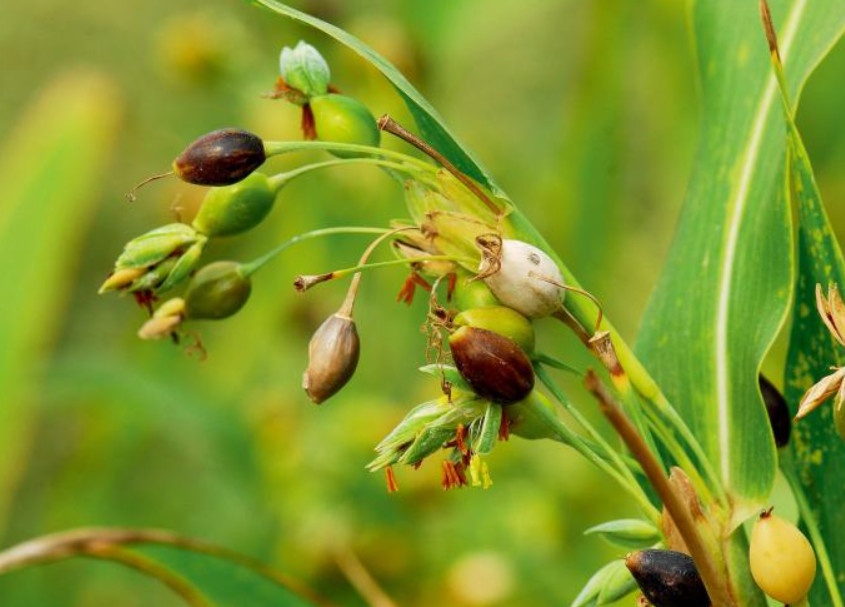
Coix seeds are broad oval or elongated oval in shape, measuring 4-8mm in length and 3-6mm in width. The surface is milky white and smooth. One end is blunt and rounded, while the other end is wider and slightly concave, with light brown dotted hilum. The back is rounded and convex, and the belly has a longitudinal groove. The texture is firm, and the cross-section is white and powdery. It has a slight aroma and a mildly sweet taste. Clinically and for home use, the best quality is characterized by large, full grains, white color, and no broken husks.
Coix seed is a traditional food resource in China and was one of the earliest grains collected for consumption by our ancestors.The nutritional components of coix seed are primarily starch, with crude protein content of 13%-14%, and 2%-8% fats. The active components mainly include coix seed oil and coix polysaccharides, which have anti-tumor effects, enhance immunity, and lower blood sugar levels. The drug Kanglaite is primarily made from coix seed oil and is suitable for adjuvant therapy for non-small cell lung cancer and primary liver cancer.
Ancient Coix Seed
History of Consumption
One
The ancient method of consuming coix seed was “removing the shell and cooking the seed into porridge”;
In the Tang Dynasty, Lu You’s poem “Coix Seed” describes the essence of coix porridge: “Initially, I cooked coix seed in Tang An, the porridge was as beautiful as the carved Hu (note: a type of aquatic plant used as a staple food before the Tang Dynasty, which declined after the Song Dynasty). As large as the water chestnut, white as jade, smooth and fragrant, filling the room with aroma.”
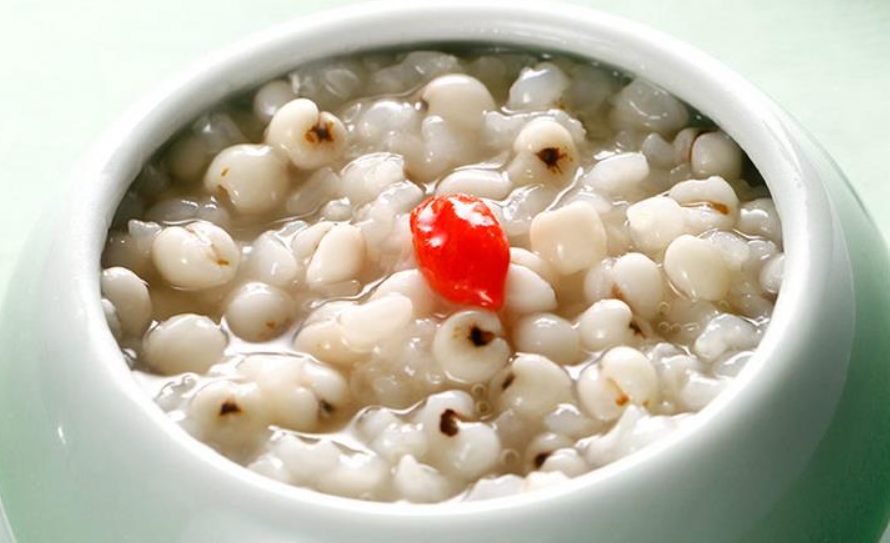
This method of consuming porridge has been commonly used throughout Chinese history for several reasons:
1. In ancient times, the tools for processing and cooking grains were relatively primitive, making it simpler to cook whole grains into porridge;
2. Coix seeds are large and hard, requiring long cooking times to be edible;
3. Porridge is easy to digest and does not harm the spleen and stomach, promoting health;
4. Due to limited food production in ancient times, food shortages could occur, and porridge has a high digestibility and absorption rate, preventing waste of precious food resources, which is also beneficial for food distribution during shortages.



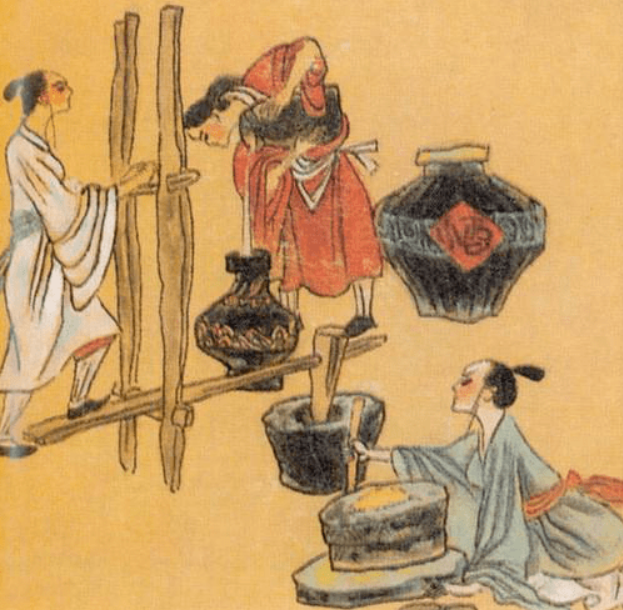
The Xia Dynasty had advanced brewing techniques, and when coix seeds were harvested, they were used to brew wine. The wine of the Xia Dynasty was primarily coix seed wine, used for sacrificial offerings and festive banquets. Thus, coix seed not only became an important food for the Xia people but also symbolized cultural and political significance, even becoming a totem of the Xia people, creating the myth of Yu’s birth from “swallowing the divine pearl coix seed”.
After the Xia, Shang, and Zhou Dynasties, with changes in climate and advancements in agricultural conditions, coix seeds, which had low yields and were not suitable for intensive production, gradually got replaced by millet, wheat, and rice crops, with their use in daily life shifting more towards health and medicinal purposes.In the 17th year of Jianwu in the Eastern Han Dynasty (41 AD), during the rebellion in Jiaozhi (present-day Vietnam), Emperor Guangwu of Han sent the general Ma Yuan, who had a lifetime of military service, to lead over 20,000 soldiers south to quell the rebellion. Over the years, soldiers from the Central Plains suffered greatly from the hot and humid jungles of the south, with reports stating, “the rain and mist were heavy, and the poisonous miasma was intense,” leading to a mortality rate of 14-15% among the military officials due to pestilence. They relied on the local method of consuming coix porridge to clear heat and eliminate dampness, maintaining the army’s combat effectiveness, which ultimately led to a successful suppression of the rebellion. Coix seed thus played a significant role in this historical event.
In the late Eastern Han Dynasty, the Shennong Bencao Jing classified coix seed as a superior product, describing it as “treating muscle spasms, preventing bending and stretching, alleviating wind-dampness, and reducing qi. Long-term consumption lightens the body and boosts qi,” making it a valuable remedy for both treating diseases and promoting health.


Coix Seed
Summary of Clinical Practice
Two
From the Han Dynasty to the present, in over two thousand years of clinical practice with coix seed, we have summarized its clinical applications into several aspects:
1. Symptoms of poor appetite, fatigue, diarrhea, and loose stools due to Spleen Qi Deficiency with Dampness. In this case, coix seed is often combined with Poria (Fu Ling), White Hyacinth Bean (Bai Bian Dou), Dried Tangerine Peel (Chen Pi), Water Chestnut (Qian Shi), and Lotus Seed (Lian Zi), with classic formulas such as Shen Ling Bai Zhu San for internal medicine, Li Pi Cake for the elderly, and Zi Sheng Wan for “women in the first three months of pregnancy with Spleen deficiency and vomiting, or unstable fetus”.
2. Edema, difficulty urinating, or painful and difficult urination due to Bladder Damp-Heat. Often combined with Mung Beans (Lv Dou), Winter Melon Skin (Dong Gua Pi), and Corn Silk (Yu Mi Xu), boiled in water or cooked into porridge.
3. Muscle spasms, joint pain, and weakness in the legs and knees due to Wind-Damp Bi Syndrome. Commonly used with warming and blood-activating wines.
4. Lung abscess with purulent cough or abdominal abscess with pain due to Internal and External Abscesses. For example, the Chi Xiao Dou Yi Ren Tang from the Yi Zong Jin Jian uses coix seed and red beans boiled in water to treat intestinal abscesses with pus. Another example is the coix seed juice from the Women’s Good Formula Supplement, which uses coix seed boiled in water for frequent drinking to treat long-term sores during pregnancy.
5. Cough. Commonly used with Chinese Yam (Shan Yao) to treat the lungs. For example, for children with lung heat and persistent cough at night, the Qi Xiao Liang Fang uses one portion of coix seed, three portions of Chinese yam, thirty pieces of bamboo leaves, and two slices of pear, boiled in two large bowls of water until reduced to one bowl, to be consumed as tea. Another famous recipe, Zhuyubao Erbao Porridge, treats Yin deficiency cough.
6. Others. For example, Professor Yue Meizhong has experience using coix seed for:removing skin warts, “For treating warts, coix seed has a good effect. Grind it into powder and take 10 grams daily or decoct 30 grams, generally falling off in about a month.” Andtreating chronic nephritis in children with “New Huangqi Porridge”.
Yue Meizhong addresses the prolonged difficulty in treating chronic nephritis in children and the physiological characteristics of children’s organs:
Using the method of benefiting Qi and promoting urination:
In the formula, “30 grams of raw Huangqi (Astragalus), 30 grams of raw coix seed, 15 grams of red beans, 9 grams of chicken inner gold (finely powdered), two pieces of kumquat cake, and 30 grams of glutinous rice, with the Qi-boosting Huangqi and urination-promoting coix seed forming a foundational combination.“The specific method is:
First, boil Huangqi in water for 20 minutes, remove the residue, then add soaked coix seed and red beans, and cook for 30 minutes;

Then add chicken inner gold and glutinous rice, and cook until it becomes porridge.

Take in two doses daily, chewing one piece of kumquat cake after meals to aid digestion.
After one month, if kidney function improves and proteinuria disappears, continue taking for 1-2 months until kidney function fully recovers and proteinuria completely disappears, then continue for another 3 months to consolidate the effect. Proper rest should be arranged to prevent relapse.
Coix Seed
Precautions for Use
Three
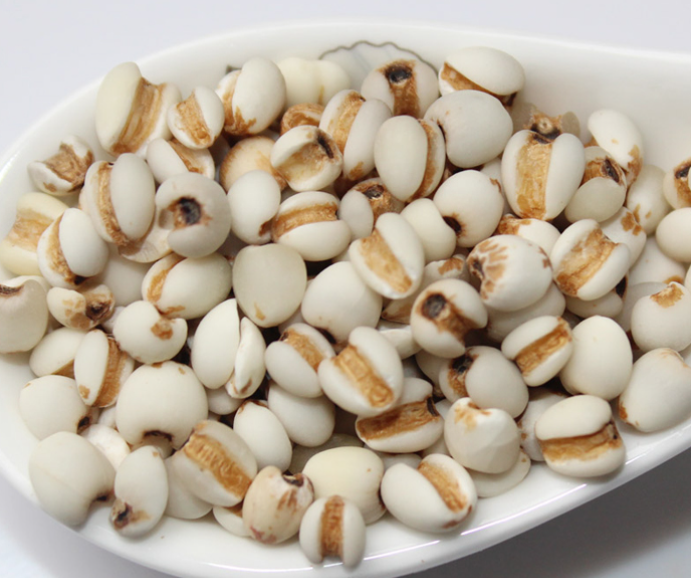
Over the centuries of clinical practice, we have accumulated a wealth of experience in the application of coix seed. TCM has summarized the properties, core effects, preparation methods, usage, and precautions for coix seed:
【Nature and Taste】: Sweet, bland, slightly cold. It enters the Spleen, Stomach, and Lung meridians.
【Functions】: Strengthens the Spleen and benefits Qi, promotes urination and drains dampness, dispels wind-dampness, and eliminates pus and abscesses. (Note: Strengthening the Spleen and benefiting Qi is a common effect of all grains; the power to dispel dampness is gentle yet effective, especially adept at eliminating lower body dampness and muscle dampness; when combined with different medicinal foods, it can dispel dampness accompanied by heat or wind, and eliminate both external and internally generated dampness. For example, the pus and blood from abscesses are formed from the normal qi, blood, and body fluids of the human body, where qi stagnation generates heat, fluids become damp, and blood stagnation leads to stasis. The yellow and white pus is caused by the stagnation of fluids, thus the effect of eliminating pus and draining abscesses also reflects its ability to dispel dampness.)
【Preparation】: Can be used raw or stir-fried. When stir-frying, clean coix seeds are placed in a pan and stir-fried over low heat until slightly yellow, then removed and cooled. The surface may show scorch marks and have a fragrant aroma. Alternatively, it can be stir-fried with bran (10 pounds of coix seed with 1 pound of bran) or with glutinous rice in equal amounts, which enhances the Spleen-strengthening effect and balances the cold and hot properties.
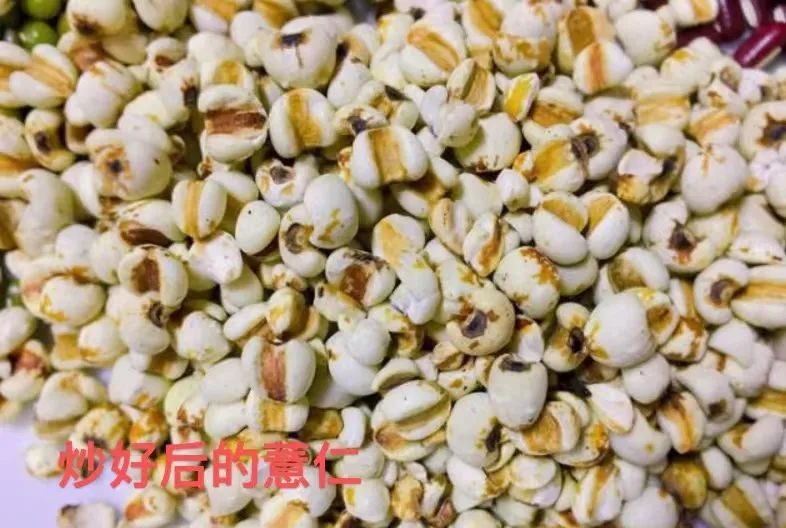
【Usage】: For internal use: decoct in soup; or in pills, powders, soaked in wine, cooked in porridge, or made into soups. For external use: powdered and applied topically.

 【Precautions for Use】1.Suitable for those with phlegm-dampness and damp-heat constitution, especially those with Spleen Qi deficiency; not suitable for those with Spleen deficiency without dampness, dry constipation, or Spleen and Stomach cold deficiency.2. For strengthening the Spleen and benefiting Qi to stop diarrhea, it is advisable to usestir-fried (with glutinous rice), as stir-frying reduces its cold nature; for promoting urination, dispelling dampness, and eliminating pus and abscesses, especially when dampness is accompanied by heat, it is advisable to useraw.3. This product has a gentle effect, promotes urination without harming Yin,and is suitable for long-term use.4.It is advisable to prepare it as food, often used with japonica rice to cook porridge. This product is hard, requiring pre-cooking until half-done before mixing with japonica rice for cooking until the porridge is thick and sticky.5. Due to its property of promoting urination and downward movement, there is concern about miscarriage,pregnant women should use with caution. However, the previously mentioned Zi Sheng Wan can also be used for pregnant women with a tendency to miscarriage, which may seem contradictory, but the reason is that when coix seed is combined with tonic herbs and foods for dampness, it can be beneficial without harm. Thus, the medicinal food is merely a tool, and the key to its application lies in the methods and techniques used.
【Precautions for Use】1.Suitable for those with phlegm-dampness and damp-heat constitution, especially those with Spleen Qi deficiency; not suitable for those with Spleen deficiency without dampness, dry constipation, or Spleen and Stomach cold deficiency.2. For strengthening the Spleen and benefiting Qi to stop diarrhea, it is advisable to usestir-fried (with glutinous rice), as stir-frying reduces its cold nature; for promoting urination, dispelling dampness, and eliminating pus and abscesses, especially when dampness is accompanied by heat, it is advisable to useraw.3. This product has a gentle effect, promotes urination without harming Yin,and is suitable for long-term use.4.It is advisable to prepare it as food, often used with japonica rice to cook porridge. This product is hard, requiring pre-cooking until half-done before mixing with japonica rice for cooking until the porridge is thick and sticky.5. Due to its property of promoting urination and downward movement, there is concern about miscarriage,pregnant women should use with caution. However, the previously mentioned Zi Sheng Wan can also be used for pregnant women with a tendency to miscarriage, which may seem contradictory, but the reason is that when coix seed is combined with tonic herbs and foods for dampness, it can be beneficial without harm. Thus, the medicinal food is merely a tool, and the key to its application lies in the methods and techniques used.
 Regarding the characteristics of coix seed’s effects, many medical scholars throughout history have provided insightful summaries, and here are some excerpts:
Regarding the characteristics of coix seed’s effects, many medical scholars throughout history have provided insightful summaries, and here are some excerpts:
Shennong Bencao Jing: “It treats muscle spasms, prevents bending and stretching, alleviates wind-dampness, and reduces qi. Long-term consumption lightens the body and boosts qi.”
Suixi Ju Yin Shi Pu: “Boil in soup. It can also be steamed, cooked in porridge, or rice, all of which are suitable. Those with weak spleens and difficult bowel movements should not consume too much. Its nature is primarily downward, and pregnant women should avoid it.”
New Compilation of Materia Medica: “All diuretic medicines should be used in moderation, but excessive use of diuretics can damage true Yin energy… Only coix seed promotes urination without harming true Yin energy.”
Pharmaceutical Chemical Meaning: “Coix seed, sweet in taste and harmonious in qi, clears the turbid from the clear, strengthens the Spleen Yin, and greatly benefits the intestines and stomach… If there is persistent coughing with blood and reduced appetite, it can be used with gentle qi harmonizing power, and doubling the dosage will yield effective results.” (Note: Thus, the Zhuyubao Erbao Porridge uses it as an assistant and adjunct.)
Materia Medica Commentary: “Coix seed dispels dampness without the drying effect of other herbs, clears heat without damaging Yin like other herbs, and benefits qi without the damp-heat effects of ginseng and atractylodes, making it a key medicine for benefiting Qi. However, its taste is bland, and its effect is gentle, so if not combined with other herbs, it may not achieve the desired effect.”
New Compilation of Materia Medica: “Coix seed is best at promoting urination without depleting true Yin energy. For those with excessive dampness in the lower body, it is most suitable. Depending on the severity of the illness, the dosage can be adjusted, ensuring that Yin and Yang are not harmed, and dampness diseases are easily resolved. Therefore, whenever encountering dampness symptoms, using one or two taels of coix seed as the main ingredient, along with Spleen-strengthening and damp-dispelling flavors, has never failed to yield quick results. If the gentle nature of its taste is diluted and used lightly, it will be of no benefit.”
It is evident that medical practitioners primarily focus on two points: one is the excellent damp-dispelling effect with minimal side effects, making it safe for use; the second is its gentle power, thus requiring a larger dosage to achieve efficacy.What specific dosage is needed to achieve efficacy?“In dietary therapy, adults should at least start with one tael.”
Coix Seed
Reference Formulas
Four
1. Shen Ling Bai Zhu San
【Source】”Taiping Huimin Heji Bureau Formula” Volume 3.
【Alias】Shen Zhu Drink (“Zhang’s Medical Communication” Volume 16).
【Composition】Lotus Seed (peeled) Coix Seed Cardamom Platycodon (stir-fried until deep yellow, all 1 part) White Hyacinth Bean (soaked in ginger juice, peeled, lightly stir-fried, 1.5 parts) White Poria, Ginseng (peeled) Licorice (stir-fried) White Atractylodes, Chinese Yam (all 2 parts)
【Usage】Grind into a fine powder, take 5-10g each time, mixed with jujube soup, adjusting the dosage for children based on age.
【Function】Tonifies Qi, strengthens the Spleen, and promotes dampness drainage.
【Indications】Spleen and Stomach Qi deficiency, poor appetite, fatigue, fullness and distension, palpitations, shortness of breath, vomiting, diarrhea, and weak pulse.
2. Zi Sheng Wan
【Source】”Lantai Guideline” Volume 1.
【Alias】Zi Sheng Jian Pi Wan (“Lantai Guideline” Volume 1).
【Composition】Ginseng Atractylodes (all 3 parts) Chinese Yam, Poria, Lotus Meat, Dried Tangerine Peel, Malt, Medicinal Ferment (all 2 parts) Coix Seed, Water Chestnut, Cardamom, White Hyacinth Bean, Hawthorn (all 1.5 parts) Licorice, Platycodon, Patchouli (all 1 part) White Cardamom (0.8 parts) Coptis (0.4 parts)
【Usage】Grind into a fine powder, mix with honey to form pills the size of a marble, take two pills with rice drink.
【Function】Benefits Qi, strengthens the Spleen, and stabilizes the fetus.
【Indications】Women in the first three months of pregnancy with Spleen deficiency and vomiting, or unstable fetus, also beneficial for husbands to regulate the middle and nourish the stomach, satisfying hunger and fullness.
3. Chi Xiao Dou Yi Ren Tang
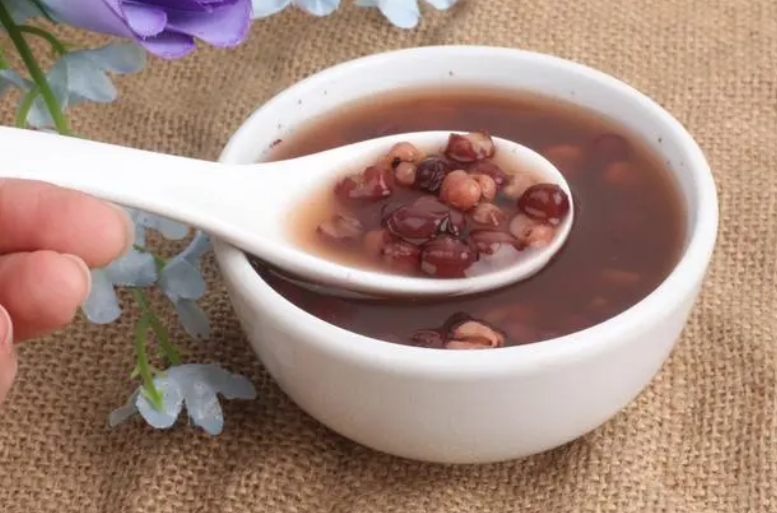
【Source】”Yi Zong Jin Jian” Volume 67.
【Composition】Red Beans Coix Seed Fangji Licorice (all equal parts)
【Usage】Boil in two bowls of water, reduce to one bowl, take on an empty stomach.
【Function】Clears heat, detoxifies, and drains pus.
【Indications】Stomach abscess, large and small intestinal abscess, with established pus, and a rapid pulse.
4. Coix Seed Porridge
【Source】”Essentials of Health” Post-Collection on Elderly Care
【Composition】Coix Seed 200g, Japonica Rice 150g
【Usage】Cook into porridge, no time restrictions.
【Function】Strengthens the Spleen, dispels dampness, and alleviates wind-dampness, strengthening muscles and bones.
【Indications】Daily conditioning for the elderly with Spleen and Stomach weakness, especially those living in damp areas. (Note: This simple yet effective damp-dispelling dietary therapy is recommended for families in the damp southern regions of China.)
5. Zhuyubao Erbao Porridge (Note: Coix seed resembles pearls, and Chinese yam resembles jade, hence the name Zhuyubao Erbao Porridge)
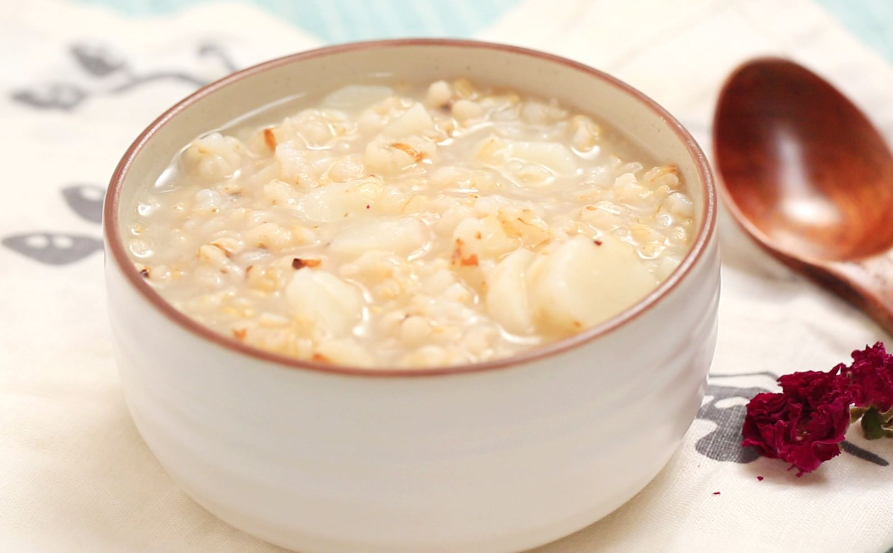
【Source】”Medical Records of Traditional Chinese Medicine”
【Composition】Raw Chinese Yam 100g, Raw Coix Seed 100g, Persimmon Frost or Rock Sugar 25g
【Usage】Combine the three ingredients, cut the yam into small pieces, and cook with coix seed until soft, then add persimmon frost to dissolve, and consume as desired.
【Function】Nourishes Yin and dispels dampness.
【Indications】Treats deficiency of Yin in the Spleen and Lung, poor appetite, and deficiency heat cough, as well as all symptoms of Yin deficiency. Suitable for those with a Yin-deficient constitution.
6. Coix Seed Daohong Tea (Note: The original text does not have a formula name. This formula has the flavor of Daohong San, hence the name.)
【Source】”Collection of Effective Formulas” Volume on Pediatrics
【Composition】Coix Seed 100g, Chinese Yam 10g, Bamboo Leaves 5g, Pear 50g
【Usage】Boil in two large bowls of water until reduced to one bowl, consume as tea several times a day until recovery.
【Function】Promotes urination, guides heat, moistens the lungs, and stops cough.
【Indications】Treats lung heat in children, persistent cough and wheezing at night. (Note: Children have delicate Yin and Yang, and their organs are tender. Lung heat can cause prolonged cough and damage the body’s righteousness, so using the gentle coix seed and bamboo leaves to promote urination and guide heat downward, while Chinese yam and pear moisten the lungs and stop cough, protects the body’s righteousness.)
7. Qian Shi Porridge
【Source】”Concise Medical Compendium” Volume 7, Guangsi Section
【Composition】Qian Shi (1 liter, cleaned) White Liang Rice (3 cups) Lotus Meat (soaked and peeled) Coix Seed (fresh) Chinese Yam Powder (all 1 cup) (Note: White Liang Rice is a type of millet, sweet in taste and slightly cold in nature, with the function of benefiting Qi and harmonizing the middle, dispelling vexation and stopping thirst. This formula uses Qian Shi as the main ingredient, with coix seed for dampness elimination, to nourish without stagnation.)
【Usage】Grind into powder, mix with four taels of sugar, and take several cups daily as a substitute for breakfast porridge. It strengthens the Spleen, nourishes the kidneys, and benefits essence.
【Function】Strengthens the Spleen, solidifies the kidneys, and benefits essence.
【Indications】For men with clear essence infertility; for elderly health care, etc. It can also be used for Spleen deficiency diarrhea and women’s leukorrhea.
It is evident that coix seed is not only edible but also has a wide range of medicinal and health applications.In addition, due to the groove in the middle of its seeds, they can be strung together to make bracelets, necklaces, and other ornaments. In ancient times, they were used as accessories in daily life, even comparable to jade. Origin of the “Pearl of Coix” or “Slander of Coix”
Origin of the “Pearl of Coix” or “Slander of Coix”

When General Ma Yuan was on his expedition to Jiaozhi, he discovered that the coix seeds produced in Vietnam were large and had a bright color, shining like pearls. Upon his victorious return to Luoyang, he brought back a cartload of coix seeds as seeds. Unexpectedly, this cartload of coix seeds triggered a famous political scandal.At that time, Ma Yuan was already old and had endured many battles, and soon passed away. Before his body was even cold, a group of people came forward to accuse him, claiming that the usually honest Ma Yuan was actually a corrupt official who had plundered the people, and that the cartload of the best pearls he brought back from Jiaozhi was the evidence.Emperor Guangwu of Han, without verifying the facts, believed the slander and angrily ordered Ma Yuan to be stripped of his title.Poor loyal general, wrapped in horsehide, buried in the wild, unable to have a proper burial.Later, his family risked their lives to appeal six times, expressing their deep sorrow, and only then did Emperor Guangwu allow them to hold a funeral for Ma Yuan. A once-great general, loyal and honest, ended up in such a fate, which is truly heartbreaking. In response, Du Fu lamented, “The rice and grain are not enough, why is the slander of coix so frequent?”; Su Dongpo also expressed his feelings, writing a poem: “The Fubo rice coix, the divine remedy against miasma. It can eliminate the poison of Wuxi, but cannot save from slander.” This reflects the sadness that while coix seed can dispel the dampness of heaven and earth, it cannot eliminate the filth of humanity.The “Pearl of Coix” is both a song of praise for the honest and upright, and a lament for those who have been slandered and are powerless to defend themselves.
In response, Du Fu lamented, “The rice and grain are not enough, why is the slander of coix so frequent?”; Su Dongpo also expressed his feelings, writing a poem: “The Fubo rice coix, the divine remedy against miasma. It can eliminate the poison of Wuxi, but cannot save from slander.” This reflects the sadness that while coix seed can dispel the dampness of heaven and earth, it cannot eliminate the filth of humanity.The “Pearl of Coix” is both a song of praise for the honest and upright, and a lament for those who have been slandered and are powerless to defend themselves.
The legends and stories of coix seed resonate through the ages, forming a shared memory among the Chinese people. The applications and practices of coix seed have accumulated into a valuable experience passed down through generations, continuing to this day.
 Finally, we conclude with the earliest poem about coix seed.Since the Tang and Song Dynasties, coix seed has frequently appeared in poetry and literature. However, coix seed was already widely celebrated in the era of the “hungry sing of their food, the laborers sing of their work” in the Book of Songs. The poem “采采芣苢” in the Book of Songs reflects the joy of women harvesting coix seed during an era of “innocent thoughts”. Food is precious, and the joy of harvesting food is doubled when working together with companions. This is a song of labor, how beautiful!
Finally, we conclude with the earliest poem about coix seed.Since the Tang and Song Dynasties, coix seed has frequently appeared in poetry and literature. However, coix seed was already widely celebrated in the era of the “hungry sing of their food, the laborers sing of their work” in the Book of Songs. The poem “采采芣苢” in the Book of Songs reflects the joy of women harvesting coix seed during an era of “innocent thoughts”. Food is precious, and the joy of harvesting food is doubled when working together with companions. This is a song of labor, how beautiful!
“采采芣苢” (采采: flourishing appearance. 芣苢 (fúyǐ): plant name, believed to be coix seed. 薄言: a phrase with no meaning. 采: to gather. 有: to collect. 掇 (duō): to pick. 捋 (luō): to take its seeds. 执衽谓之袺 (jié): to use the hem of clothing to hold things. 执衽谓之襭 (xié): to turn the hem of clothing and tuck it into the waistband to hold things.)
With its concise verses, reading it several times evokes images of riverside paths, evening sunlight on flowing water, heavy coix seeds, and graceful women joyfully gathering, their postures enchanting… The more one reads, the more vivid and striking it becomes, striking deep into the heart. When sipping coix porridge, it is best to savor this innocent thought, nourishing both body and spirit, bringing joy to both.
In the lower right corner, please give a thumbs up and “Looking“
and “Looking“
Wishing you better health!


Scan the QR code to obtain
more health knowledge

Follow for a healthy lifestyle

